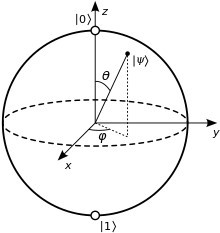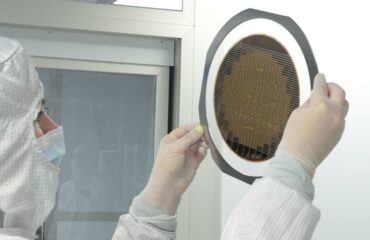
Photonic quantum computers encode information on qubits made from particles of light. Image: Gerd Altmann, from Pixabay.
By James Myers
Toronto-based quantum computing company Xanadu has announced the creation of “the world’s first error-resistant photonic qubit.” The news, published this June in the journal Nature, promises significant advancements in the creation of powerful, fully-functional quantum computers.

The qubit provides a spherical distribution of probabilities in the quantum computer, where signals are both on (denoted by “1”) and off (denoted by “0”) simultaneously. There is zero time difference between each state that comprises half the qubit, unlike today’s computer bits that require time to switch from one state to the other. Image of Bloch sphere: Wikipedia
Qubits, or quantum bits, are the quantum computer’s analog of the bits that process information in computers now in common use. Persistent connection errors among qubits, called decoherence, have been the biggest barrier to the advance of quantum computing. Fragile qubits are susceptible to interference from electromagnetism and other disruptions from the surrounding environment, problems that Xanadu’s new qubit is designed to minimize.
Quantum computing with light promises greater accuracy in measuring quantum states.
Xanadu uses pulses of light particles called photons to create qubits.
The structure of a qubit is much more complicated than a regular computer bit, but the complexity gives the qubit a vast speed advantage for processing. A conventional computer bit is limited to operating in only one of two states at any time – called “on” and “off”, or “1” and “0” – but a qubit operates in both states simultaneously. That’s because, unlike the two-dimensional regular computer bit, a qubit is spherical and operates in three dimensions. The geometry of spheres gives qubits far greater potential for information processing than today’s computer bits, but makes them extremely difficult to control and measure.
Xanadu explains that its photonic technology is capable of scaling to one million qubits operating with four components, the first of which replaces quantum gates with light measurements. The next three components connect the qubits with beamsplitters, using optical switches to route successful connections to a final phase where a laser is used to count photons of light. If the count reveals a specific pattern of photons, it indicates that a qubit has been successfully created.

Harmonic oscillation is illustrated in these two panels. The top panel depicts a wave function that oscillates around fixed points, while the bottom panel shows 30 excited states of a quantum harmonic oscillator. The dotted lines indicate the limited measurements that conventional computers can make, while the solid lines illustrate the far greater density of probabilities measured in a quantum computer. Image by Mathphysman on Wikipedia.
Xanadu states that it has created a special type of qubit, known as a GKP qubit, encoded in particles of light. Photonics is one of several different approaches to achieving full-scale quantum computing. Other types of quantum computers include those that rely on the process of annealing or on trapped ions to produce their computations.
The GKP qubit is named after physicists Daniel Gottesman, Alexei Kitaev, and John Preskill who published in 2001 an error-correcting process for photonic qubit encoding. The process was based on the idea that a qubit can be encoded in a quantum harmonic oscillator that gauges fluctuations in light waves. Quantum measurements can be made efficiently in the changing wavelengths of light, accurately capturing a wide range of probabilities as the photonic qubits oscillate in the full range of possible states between 0 and 1.
GKP qubits operate on quantum states called “squeeze states.” In squeeze states, the fluctuations, or oscillations, in one part of a light field are reduced with the result that the fluctuations in another part of the light field increase to maintain overall equilibrium. This allows for indirect measurement of quantum cause and effect in the light field using the Uncertainty Principle, because the squeeze states are equally spaced apart.
Introduced in 1927, the Uncertainty Principle states that increasing knowledge about the position of a quantum particle decreases knowledge about its momentum (which is the particle’s mass, speed, and direction) and, conversely, the more that is known about a particle’s momentum the less determinable its position is. That’s because of the observer effect in which, for reasons still unknown, the act of directly measuring a quantum state changes the state and makes it impossible to obtain a precise measurement. (For more on the observer effect, see our May 2024 feature The Observer Effect: Why Do Our Measurements Change Quantum Outcomes?).
Owing to uncertainties, quantum measurements are probabilistic and require complex calculations to narrow probabilities down to a range that can be used in quantum algorithms. The Uncertainty Principle provides a mathematical relationship to gauge probabilities of quantum position and momentum, and GKP qubits provide several major benefits for measurement and control.
One benefit is that a GKP qubit encodes information redundantly on many photons, providing alternative paths for information transmission when a particular path suffers an error and disconnection. Without GKP qubits, arrays of “logical” qubits are required in addition to the physical qubits that process information, to provide the stability, error-correction and fault tolerance required for useful computations. A need for separate logical qubits, however, multiplies the number of qubit connections that must be kept stable.
Another significant benefit of GKP qubits is that they can operate at room temperature, without the expense of supercooling or lasers that are required to control other types of qubits.
In creating the first GKP qubits in an integrated circuit, Xanadu’s method requires that all photons except one are counted in the output of a process. “When the detected measurement pattern meets certain criteria, the wavefunction of the unmeasured output collapses into the desired GKP qubit state,” the company states in its video that demonstrates the world’s first error-resistant photonic qubit.
The process has enabled Xanadu to produce “an ultra-low-loss integrated photonic chip fabricated on a customized multilayer silicon nitride 300-mm wafer platform, coupled over fibre with high-efficiency photon number resolving detectors, to generate GKP qubit states.” The scalability of GKP qubits, with redundant information encoding and room temperature operation, is enhanced by outputs that provide enough mathematical and geometric measurement points in a lattice structure to make them fault-tolerant.
Is the path to the future of quantum computing through photonics and QKP qubits?
Photonic quantum computing under development by Xanadu and other companies like Quandela offers a number of advantages, including the networking of quantum processors using optical fibre connections that are commercially available and widely used for existing computer networks. The accessibility of networking helps to advance the scalability of photonic quantum computing, which has now received a further boost from the creation of GKP qubits.

Networkability is a key advantage of photonic computing. Xanadu’s new photonic quantum computer, Aurora, is a network of four independent servers. Image: Xanadu .
Xanadu’s newest quantum computer, named Aurora, consists of a network of four independent servers operating 12 qubits and 35 photonic chips connected by 13 kilometres of fibre optic cabling. The network is theoretically scalable to thousands of servers and millions of qubits.
The potential for computing with photons of light offers a fresh paradigm for data processing. The Quantum Insider reports on a July 2025 study published in Nature Reviews Physics entitled The potential for multidimensional photonic computing. “The approach involves encoding data across multiple independent properties of light—such as wavelength, polarization, and spatial mode—to enable highly parallel processing with reduced latency.”
The study’s authors cite the energy efficiency of photonic computing. Its ability to process multiple data streams in parallel with little lag time holds potential for addressing the massive power consumption of the latest data centres that provide the intensive processing requirements of machine learning and generative AI.
The efficiencies of photonic computing extend to quantum computers that use qubits made with light, offering the advantage of ultra-fast processing of complex data relationships with fault tolerance made possible by a high degree of redundancy in encoding.
The latest discoveries of Xanadu and its many competitors in the rapid industrialization of quantum computing point to the growing possibility for a near-term breakthrough in error correction with enough scale to launch the full-scale proliferation of quantum computers. The theoretical speed and accuracy of the machines far outpace today’s fastest supercomputers, and researchers are continuing to expand the range of applications that quantum algorithms will unlock. Encoding GKP qubits in particles of light is a major step to our quantum computing future – and what that future will look like has yet to come into focus.




